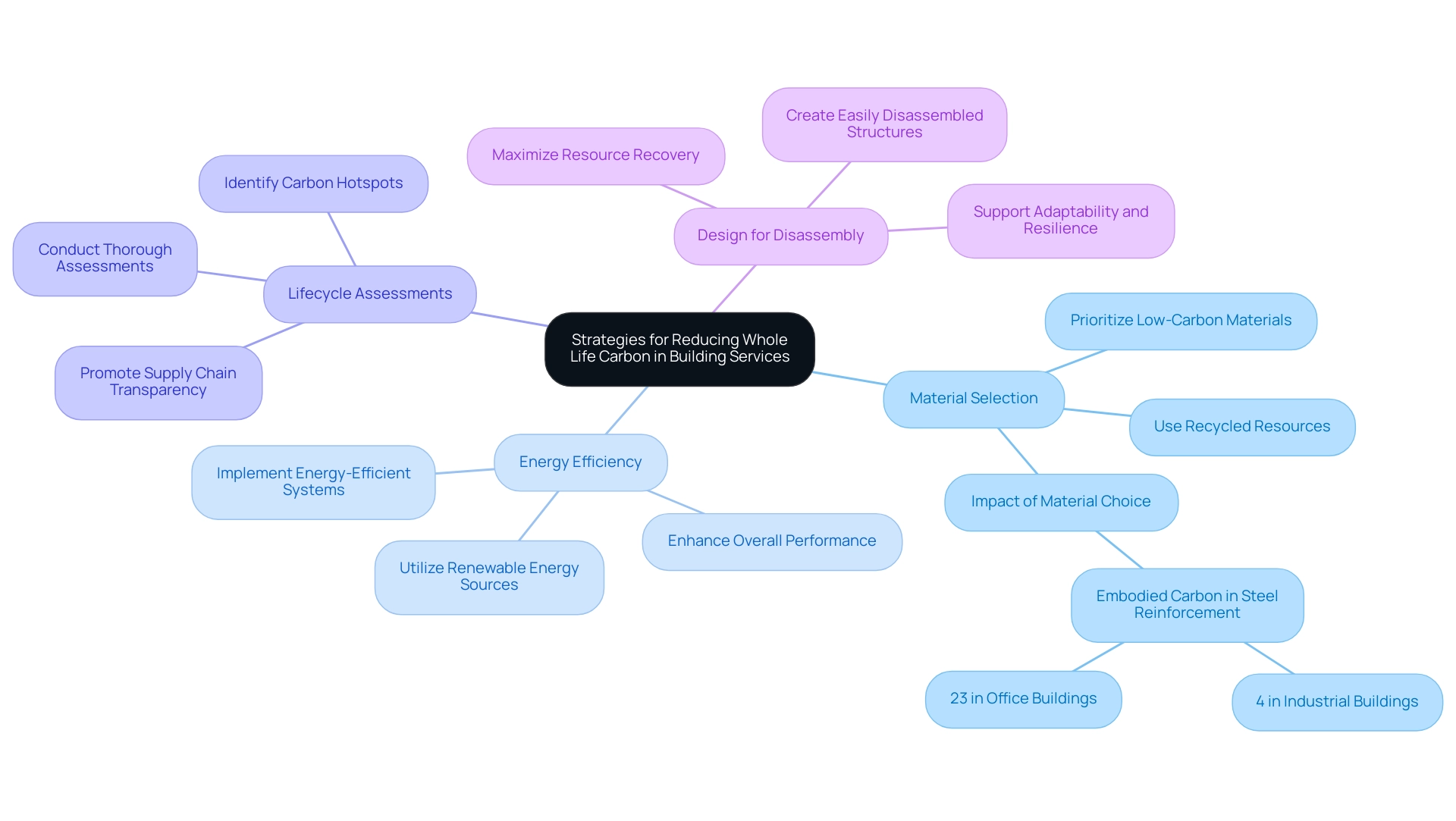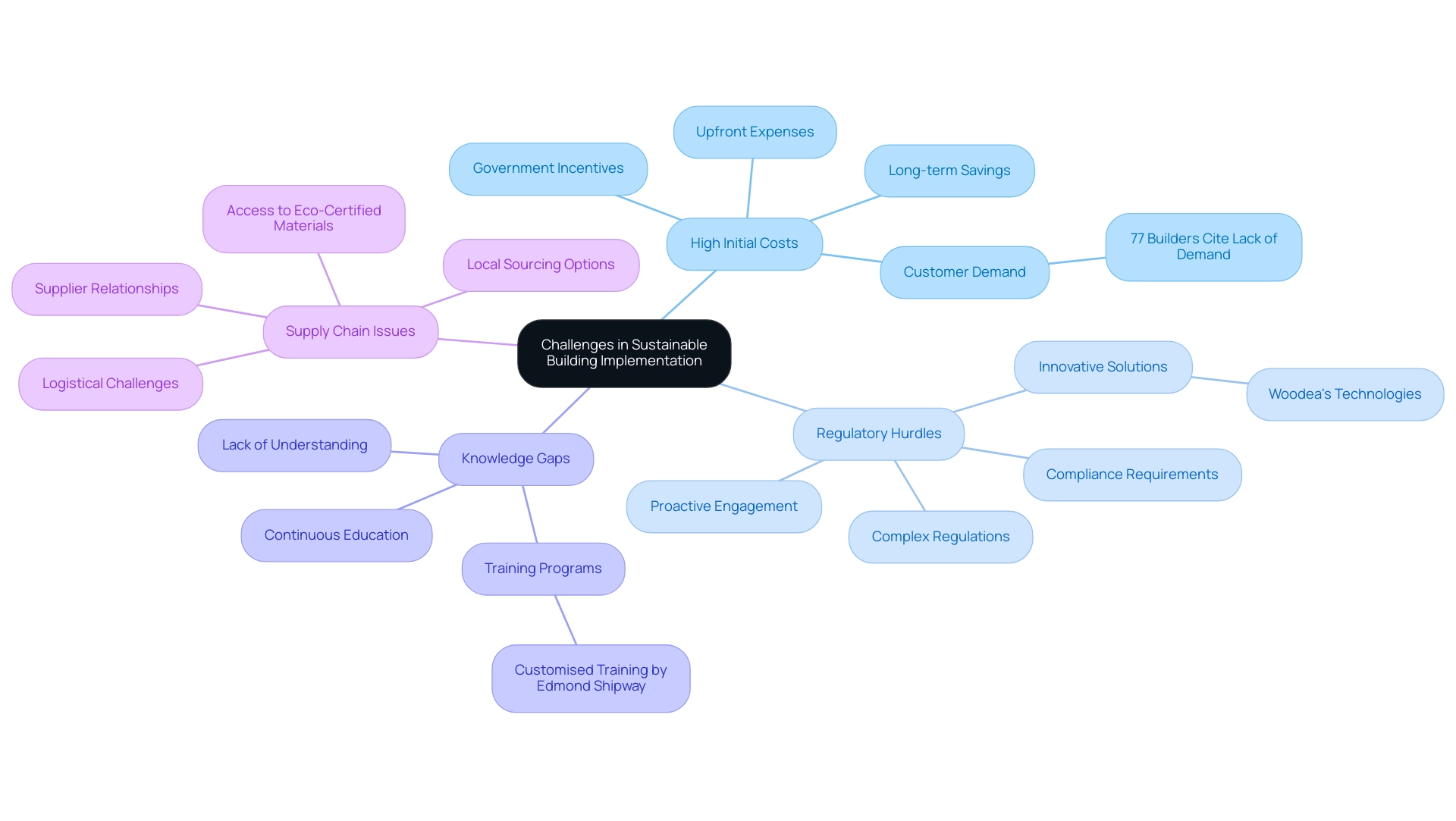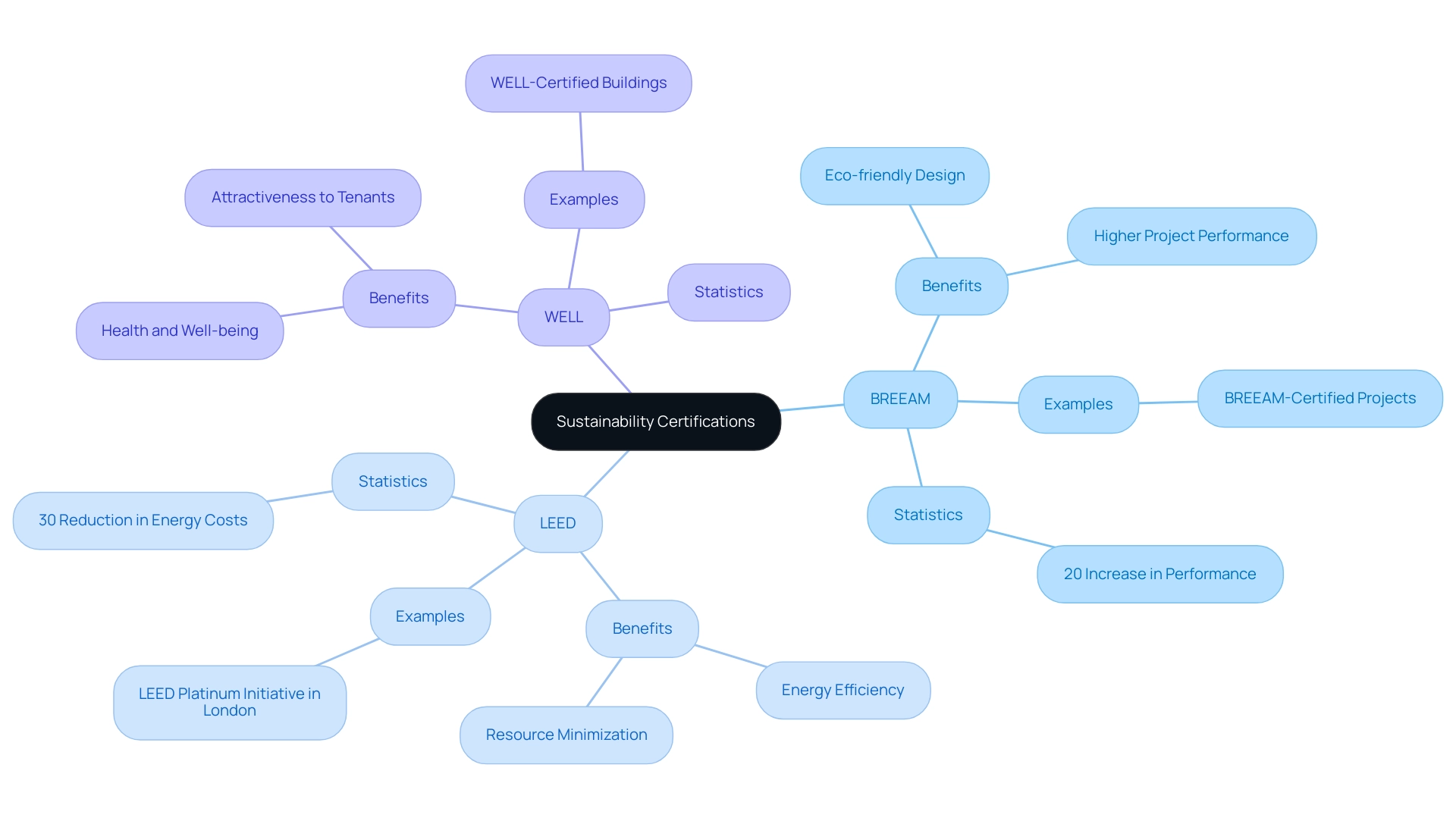27 Mar 2025
BlogOverview
This article addresses the pressing need for effective implementation strategies in sustainable building services, emphasising best practices that are crucial for success within the construction sector. It explores the integration of eco-friendly materials, energy efficiency, and innovative technologies, while also navigating the challenges posed by regulatory hurdles and initial costs. Ultimately, it demonstrates that these practices not only align with emerging standards but also significantly enhance market competitiveness and ensure long-term project viability.
Introduction
In light of escalating environmental challenges, the construction industry is undergoing a significant transformation towards sustainability. Developers and architects are increasingly prioritising eco-friendly practices, leading to the emergence of sustainable building services as a crucial strategy for minimising the environmental footprint of construction projects. This article explores the multifaceted aspects of sustainable building, examining the integration of energy-efficient designs, innovative materials, and advanced technologies that not only comply with stringent regulations but also enhance the quality of life for occupants.
With a rising consumer demand for greener alternatives and a commitment to reducing whole life carbon, the future of construction is being redefined. By analysing current trends, successful case studies, and expert insights, this exploration underscores the vital role of sustainability in shaping a resilient built environment for generations to come.
Understanding Sustainable Building Services
Sustainable building services represent a comprehensive strategy aimed at significantly reducing the environmental impact of development projects. These services encompass energy-efficient design, the utilisation of eco-friendly materials, and effective waste reduction strategies. By embracing these methodologies, developers can create frameworks that not only satisfy client requirements but also foster a positive ecological impact.
The urgency for eco-conscious practices is amplified by the escalating demand for environmentally friendly solutions within the development industry. This shift is predominantly driven by stringent regulatory frameworks and an increasing consumer preference for greener alternatives. In 2025, the development sector is witnessing a remarkable trend: eco-friendly practices are no longer optional; they are essential for compliance and market competitiveness.
Current statistics reveal that environmentally conscious services are gaining momentum, with a significant percentage of new initiatives incorporating green certifications. This trend underscores a broader commitment to sustainability, as developers recognise the long-term benefits of energy-efficient structures, which can lead to substantial cost savings and enhanced property values.
Case studies illustrate the successful implementation of environmentally conscious services across diverse initiatives in the UK. For example, a recent project highlighted the integration of renewable energy sources and advanced insulation techniques, achieving a 30% reduction in energy consumption compared to traditional buildings. Such instances underscore the tangible benefits of eco-friendly practices, not only in terms of environmental outcomes but also in improving the overall quality of life for occupants.
Expert opinions in 2025 emphasise that the future of building hinges on the implementation of innovative eco-conscious practices. As the development landscape evolves, the emphasis on sustainable building services will continue to shape the industry, driving a commitment to a greener future.
Additionally, engineering and building firms are encouraged to prioritise managing labour mismatches and enhancing technological integration, which are crucial for adapting to the changing industrial policies related to sustainability.
The Importance of Sustainability in Architecture
Sustainable building services in architecture have transitioned from a passing trend to a critical strategy for addressing climate change and resource depletion. As we move through 2025, the emphasis on these services is more pronounced than ever, with a growing acknowledgment of their significance within the construction sector. This approach not only promotes sustainable practices through efficient resource use and waste reduction but also significantly enhances the quality of life for occupants.
Architects who prioritise sustainable building services can design spaces that are both environmentally friendly and economically viable. This dual focus yields long-term benefits, such as reduced operational costs and improved occupant health. For developers, these advantages translate into increased property value and marketability, making sustainable building services a compelling investment in eco-friendly architecture.
Recent statistics underscore the urgency of adopting eco-friendly practices. In 2025, the architectural landscape is witnessing a surge in accredited programmes focused on sustainability.
Moreover, successful case studies illustrate the tangible advantages of sustainable building services in the realm of eco-friendly architecture. For example, Edmond Shipway’s sustainability consultancy has been instrumental in guiding organisations toward models that contribute to a Net Zero Carbon future. Their emphasis on energy efficiency and CO2 reduction not only distinguishes them from competitors but also aligns with contemporary building standards.
A notable example includes their work with a health care facility that achieved significant energy savings and enhanced environmental performance through eco-friendly design practices.
Client testimonials further emphasise Edmond Shipway’s dedication to excellence in consultancy and management, particularly in sustainable building services and eco-friendly practices.
Expert opinions also stress the importance of sustainability in architecture. Industry leaders assert that embracing sustainable building services is not merely a regulatory requirement but a moral imperative that can foster innovative design solutions.
In summary, the significance of sustainable building services in architecture cannot be overstated. It provides developers with a pathway to enhance results while positively impacting the environment. By embracing eco-friendly architecture and prioritising sustainable building services, developers position themselves at the forefront of industry innovation, ensuring their projects are not only successful but also responsible.
With an impressive 85% repeat business rate, Edmond Shipway’s proven track record of client satisfaction further underscores their effectiveness in delivering sustainable building services.
Strategies for Reducing Whole Life Carbon in Building Services
To effectively lower overall life carbon in facility services, stakeholders must adopt a comprehensive strategy that encompasses emissions throughout the complete lifecycle of a structure, from creation and operation to final demolition. Key strategies include:
- Material Selection: Prioritise low-carbon materials and emphasise the use of recycled or reclaimed resources. The impact of material choice on carbon emissions is significant; for instance, the embodied carbon from steel reinforcement can vary greatly, representing 4% in industrial facilities and up to 23% in office structures. This underscores the necessity of making informed material choices to minimise overall carbon output. The UK Green Building Council (UKGBC) estimates that all materials in UK construction contributed approximately 43 MtCO2 in 2024, highlighting the critical need for careful material selection.
- Energy Efficiency: Implementing energy-efficient systems and technologies is crucial. High-performance insulation and renewable energy sources not only reduce operational emissions but also contribute to long-term sustainability goals. By focusing on energy efficiency, developers can enhance the overall performance of their structures while simultaneously decreasing their carbon footprint.
- Lifecycle Assessments: Conducting thorough lifecycle assessments is essential for pinpointing carbon hotspots within an initiative. These assessments offer valuable insights into emission sources, enabling targeted strategies for reduction. The UK Green Building Council emphasises the importance of transparency and accountability throughout the supply chain, which is vital for effectively tracking embodied carbon. By advancing the use of standardised data, improving supply chain transparency, and encouraging broader industry collaboration, we can continue to make meaningful progress in reducing embodied carbon.
- Design for Disassembly: Creating buildings that can be easily disassembled and reused is a forward-thinking strategy that minimises waste and maximises resource recovery. This approach not only supports sustainability but also aligns with the increasing demand for adaptable and resilient structures in the face of climate challenges.
By integrating these strategies, developers can significantly lower the carbon footprint of their projects while enhancing their marketability. The building industry’s commitment to sustainable building services and reducing whole life carbon is not merely a regulatory obligation; it represents a crucial step towards an eco-friendly future. Sector leaders are advocating for standardised data and increased collaboration to drive significant advancements in carbon reduction. Additionally, the challenge of tracking embodied carbon throughout the supply chain necessitates ongoing efforts to ensure transparency and accountability at all stages of construction.

Overcoming Challenges in Sustainable Building Implementation
Implementing sustainable building practices presents several challenges that stakeholders must navigate effectively. Edmond Shipway is well-positioned to assist in overcoming these obstacles:
- High Initial Costs: One of the most significant barriers is the higher upfront expenses linked to eco-friendly materials and technologies. While these investments may seem daunting, it is crucial to consider the long-term savings on energy and maintenance, as well as potential government incentives that can offset initial expenditures. For instance, studies indicate that the initial costs of eco-friendly materials can be up to 10-20% higher than traditional options, yet the lifecycle savings can be substantial, often recouping the investment within a few years. Furthermore, 77% of constructors mention ‘Lack of Customer Demand’ as their primary barrier to green building, emphasising the necessity for heightened market interest in eco-friendly options. Edmond Shipway’s expertise in cost consultancy can help clients effectively identify and leverage savings through sustainable building services.
- Regulatory Hurdles: The complexity of regulations surrounding eco-friendly construction can be overwhelming. Engaging with local authorities early in the design phase is essential to clarify requirements and streamline the approval process. This proactive approach not only helps in understanding compliance but also fosters collaboration, which can lead to innovative solutions that meet regulatory standards. Our innovative technologies and customised solutions not only meet regulations but also dramatically cut carbon emissions, fostering positive change in the industry and for our planet. Edmond Shipway’s management team is skilled at navigating these regulatory landscapes to ensure compliance and efficiency.
- Knowledge Gaps: A common issue is the lack of understanding of eco-friendly practices among project teams. Continuous education and training are vital to equip teams with the necessary skills and knowledge. Workshops, certifications, and partnerships with sustainability experts can bridge these gaps, ensuring that all team members are aligned with the latest practices and technologies. Edmond Shipway provides customised training programmes to improve team skills in environmentally friendly construction.
- Supply Chain Issues: Sourcing eco-friendly materials can often be a logistical challenge. Establishing strong relationships with suppliers and exploring local sourcing options can alleviate these issues. By fostering partnerships with eco-certified material providers, stakeholders can ensure a reliable supply chain that supports sustainable building services and environmentally-friendly building goals. Edmond Shipway’s extensive network of suppliers can facilitate access to sustainable building services and materials, ensuring timelines and budgets are met.
By proactively tackling these challenges, with the assistance of Edmond Shipway’s extensive sustainable building services, stakeholders can greatly enhance their ability to efficiently apply eco-friendly practices, ultimately contributing to a greener building environment.

Navigating Certifications and Standards for Sustainable Success
Navigating the landscape of sustainability certifications is essential for ensuring that constructions comply with established environmental standards. Developers should consider several primary certifications:
- BREEAM: The Building Research Establishment Environmental Assessment Method is one of the most recognised sustainability assessment methods globally. It assesses the environmental performance of master planning initiatives, infrastructure, and structures, offering a comprehensive framework that promotes eco-friendly design and construction practices.
- LEED: The Leadership in Energy and Environmental Design certification emphasises energy efficiency and environmental impact. It provides a structured method to sustainable construction practices, assisting developers in creating spaces that minimise resource consumption and enhance occupant comfort.
- WELL: This certification focuses on the health and well-being of occupants, integrating sustainability with human health considerations. WELL-certified buildings are designed to promote physical and mental well-being, making them increasingly attractive to tenants and investors alike.
Pursuing these certifications not only demonstrates a developer’s commitment to sustainable building services but also attracts clients who are environmentally conscious. Furthermore, initiatives that achieve BREEAM certification can benefit from financial incentives, including reduced insurance premiums and increased property values.
Recent statistics indicate that BREEAM-certified projects have a significantly higher success rate, with studies showing that they can achieve up to a 20% increase in overall project performance compared to non-certified counterparts. This is especially pertinent in 2025, as the Greater London Authority requires circular economy evaluations for major development applications, emphasising the significance of eco-friendly practices in the construction sector.
Moreover, the integration of innovative technologies can significantly streamline the certification process. A case study titled “Streamlining Sustainability with Technology: Traditional Methods vs. Arbor” highlights the challenges faced by consultants in conducting manual life cycle assessments, which typically require 450 hours and cost around £50,000 per product. By utilising Arbor’s innovative platform, consultants can achieve up to a 70% decrease in timelines from contract start to delivered results, leading to more accurate carbon measurement and potentially a 25% margin increase for associated initiatives.
Expert opinions highlight the importance of navigating sustainability certifications effectively. By leveraging innovative technologies and methodologies, such as those demonstrated in case studies involving sustainable building services, developers can streamline their certification processes and achieve significant cost savings while ensuring compliance with sustainability standards.

Leveraging Technology for Enhanced Sustainability in Building Services
Technology plays a critical role in advancing sustainable building services, driven by several key innovations. Building Information Modelling (BIM) stands at the forefront of this revolution, transforming planning and resource management. By significantly minimising waste and enhancing operational efficiency, BIM has proven its efficacy in 2025, facilitating accurate visualisation and coordination among stakeholders.
The importance of BIM in sustainable building services cannot be overstated. It integrates various aspects of a project into a cohesive framework, fostering collaboration among project teams. In addition, Smart Facility Systems leverage Internet of Things (IoT) devices for real-time monitoring of facility performance, optimising energy consumption and improving occupant comfort. These sustainable building services not only promote sustainability but also enhance the overall user experience within the built environment.
Renewable Energy Technologies such as solar panels, wind turbines, and geothermal systems are essential in reducing a structure’s carbon footprint. As the demand for sustainable building services escalates, these technologies are increasingly vital in the building industry, aligning with global efforts to combat climate change. The green transition of the construction sector could unlock £1.8 trillion in market opportunities globally, underscoring the significance of these innovations.
Energy Management Software plays a pivotal role in tracking energy consumption, enabling stakeholders to identify areas for improvement. By providing actionable insights, this software empowers decision-makers to implement strategies that enhance sustainability and operational efficiency within building services.
The impact of BIM on building efficiency is particularly pronounced in 2025, streamlining workflows and fostering collaboration among teams. Expert insights affirm that BIM’s role in sustainable development is critical, as it unifies various project elements into a cohesive framework.
Moreover, recent case studies illustrate how technology is enhancing sustainability in building services. For instance, the evolving policy landscape regarding tariffs on strategic materials like steel and aluminium compels engineering and building firms to adapt. By leveraging technology, these firms can navigate potential cost increases and delivery challenges, ensuring success in a dynamic economic environment.
As the sector continues to evolve, adopting sustainable building services is vital for achieving sustainability objectives and enhancing project outcomes. The decisions made today in the building industry will significantly influence the durability and success of communities globally, making it imperative for companies to embrace eco-friendly practices.

Future Trends in Sustainable Building Services
The building sector is undergoing a significant transformation, characterised by several pivotal trends that will shape the future of sustainable building services in 2025.
- Circular Economy: This approach prioritises the reuse and recycling of materials, significantly reducing waste and resource consumption. As the industry embraces circular economy practices, projects are increasingly designed to minimise their environmental footprint. This is supported by sustainable building services that align with broader sustainability goals.
- Net-Zero Structures: A marked shift is occurring towards designing structures that generate as much energy as they consume. This trend not only supports climate objectives but also enhances the long-term viability of projects by reducing operational costs and increasing energy independence. Edmond Shipway’s commitment to sustainable building services positions them well to guide clients in achieving net-zero standards, leveraging their expertise in energy-efficient design and construction methodologies.
- Biophilic Design: The integration of natural elements into building design is gaining traction, promoting occupant well-being while reducing environmental impact. This design philosophy fosters a connection between people and nature, which is increasingly recognised as essential for enhancing the quality of life in urban environments.
- Advanced Materials: The development of innovative materials with superior sustainability characteristics, such as reduced embodied carbon, is revolutionising building practices. These materials contribute to lower environmental impacts while improving the overall performance and durability of buildings.
The anticipated expansion in the building sector, driven by urbanisation and increased investment in infrastructure, underscores the significance of these trends. As market dynamics shift, including reduced interest rates and declining inflation, financing expenses for initiatives are expected to decrease, further encouraging investments in eco-friendly development. By aligning with these trends, stakeholders can ensure their projects are not only relevant but also impactful, paving the way for sustainable building services that contribute to a more sustainable future in the construction industry.

Conclusion
The construction industry’s shift towards sustainability represents a pivotal change in building practices, emphasising environmental stewardship and occupant well-being. Sustainable building services have become essential for reducing ecological footprints while addressing the increasing demand for greener alternatives. By embracing energy-efficient designs, innovative materials, and advanced technologies, developers not only enhance property values but also lower operational costs, all while adhering to regulatory standards.
Successful case studies highlight the substantial long-term benefits of sustainable architecture, demonstrating that eco-friendly practices can yield significant savings and improve quality of life. Furthermore, technologies such as Building Information Modelling (BIM) and energy management software play a crucial role in optimising processes and advancing sustainability initiatives.
Looking ahead, trends like circular economy practices, net-zero buildings, biophilic design, and advanced materials are set to redefine construction. These approaches not only enhance project outcomes but also contribute to a resilient built environment capable of effectively addressing climate challenges.
Ultimately, the commitment to sustainability in construction transcends mere regulatory compliance; it embodies a dedication to fostering responsible development that benefits both people and the planet. By prioritising eco-friendly practices, industry stakeholders can cultivate a built environment that promotes community health and prosperity for generations to come, making sustainability an imperative for the future of construction.
Share


